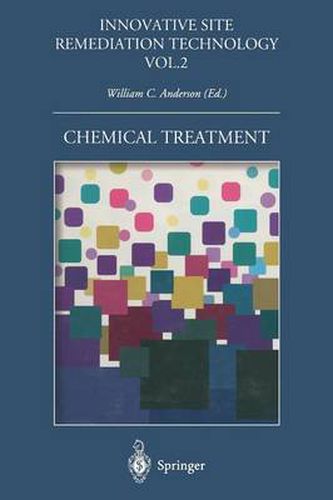Readings Newsletter
Become a Readings Member to make your shopping experience even easier.
Sign in or sign up for free!
You’re not far away from qualifying for FREE standard shipping within Australia
You’ve qualified for FREE standard shipping within Australia
The cart is loading…






This title is printed to order. This book may have been self-published. If so, we cannot guarantee the quality of the content. In the main most books will have gone through the editing process however some may not. We therefore suggest that you be aware of this before ordering this book. If in doubt check either the author or publisher’s details as we are unable to accept any returns unless they are faulty. Please contact us if you have any questions.
This monograph on chemical treatment is one of a series of eight on innovative site and waste remediation technologies that are the culmination of a multi organization effort involving more than 100 experts over a two year period. It provides the experienced, practicing professional guidance on the application of innovative processes considered ready for full-scale application. Other monographs in this series address bioremediation, soil washing/soil flushing, solvent chemical extraction, stabilization/ solidifica tion, thermal desorption, thermal destruction, and vacuum vapor extraction. 7. 7 Chemical Treatment The term chemical treatment, as used in this monograph, refers to the use of reagents to destroy or chemically modify target contaminants by means other than pyrolysis or combustion. The monograph addresses processes that chemically treat contaminated soils, groundwaters, surface waters, and, to a limited extent, concentrated contaminants. Chemical treatment is a means of converting hazardous constituents into less environmentally ob jectionable forms in order to meet treatment objectives. This monograph addresses substitution, oxidation, and chemical precipi tation processes. It addresses processes within these classes that are suffi ciently advanced for full-scale application. There are a number of emerging technologies within these classes that are in the research or an early devel opment stage, not yet ready for full-scale application, that appear to be very promising technologically. Six such technologies are briefly addressed in Appendix A.
$9.00 standard shipping within Australia
FREE standard shipping within Australia for orders over $100.00
Express & International shipping calculated at checkout
This title is printed to order. This book may have been self-published. If so, we cannot guarantee the quality of the content. In the main most books will have gone through the editing process however some may not. We therefore suggest that you be aware of this before ordering this book. If in doubt check either the author or publisher’s details as we are unable to accept any returns unless they are faulty. Please contact us if you have any questions.
This monograph on chemical treatment is one of a series of eight on innovative site and waste remediation technologies that are the culmination of a multi organization effort involving more than 100 experts over a two year period. It provides the experienced, practicing professional guidance on the application of innovative processes considered ready for full-scale application. Other monographs in this series address bioremediation, soil washing/soil flushing, solvent chemical extraction, stabilization/ solidifica tion, thermal desorption, thermal destruction, and vacuum vapor extraction. 7. 7 Chemical Treatment The term chemical treatment, as used in this monograph, refers to the use of reagents to destroy or chemically modify target contaminants by means other than pyrolysis or combustion. The monograph addresses processes that chemically treat contaminated soils, groundwaters, surface waters, and, to a limited extent, concentrated contaminants. Chemical treatment is a means of converting hazardous constituents into less environmentally ob jectionable forms in order to meet treatment objectives. This monograph addresses substitution, oxidation, and chemical precipi tation processes. It addresses processes within these classes that are suffi ciently advanced for full-scale application. There are a number of emerging technologies within these classes that are in the research or an early devel opment stage, not yet ready for full-scale application, that appear to be very promising technologically. Six such technologies are briefly addressed in Appendix A.